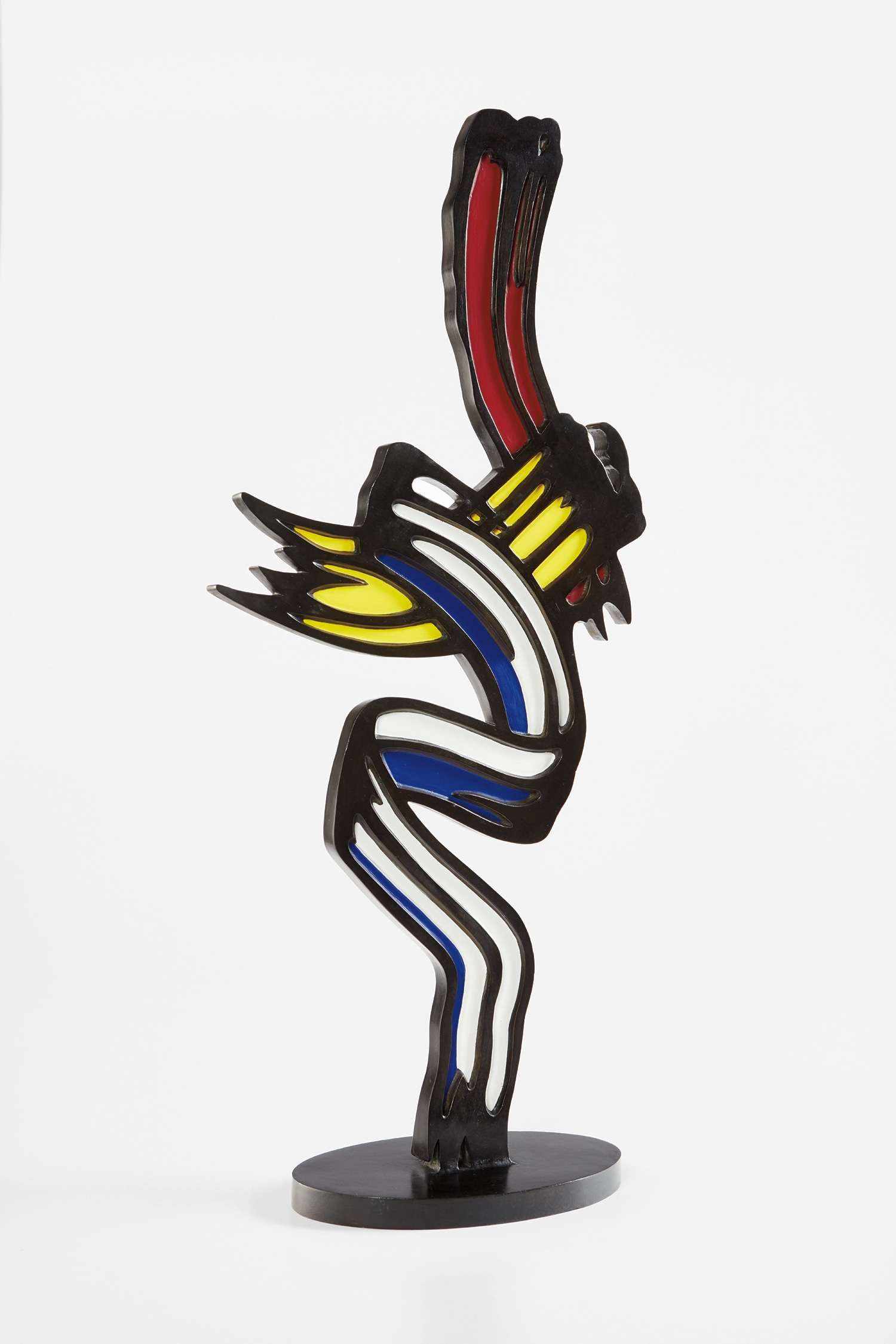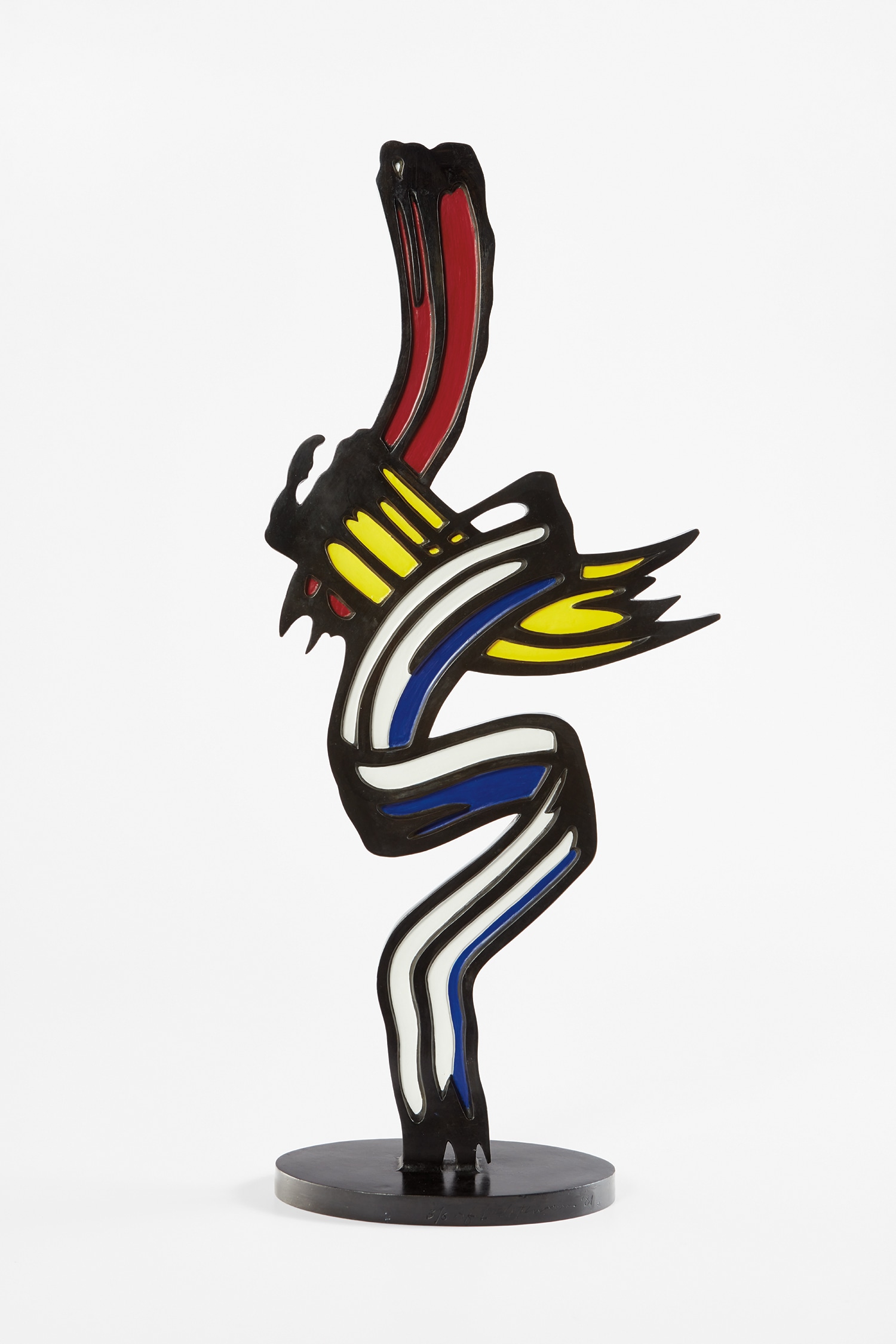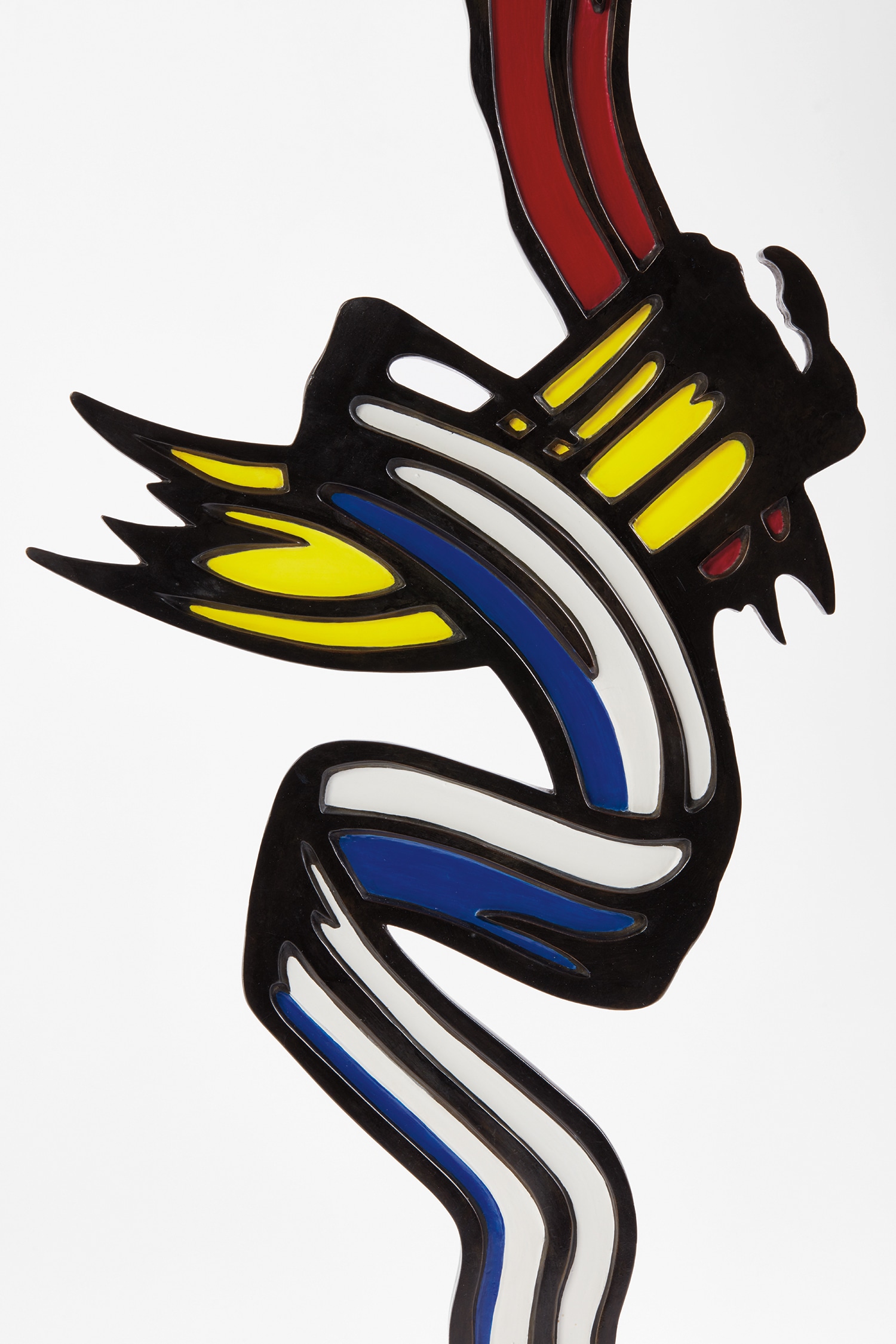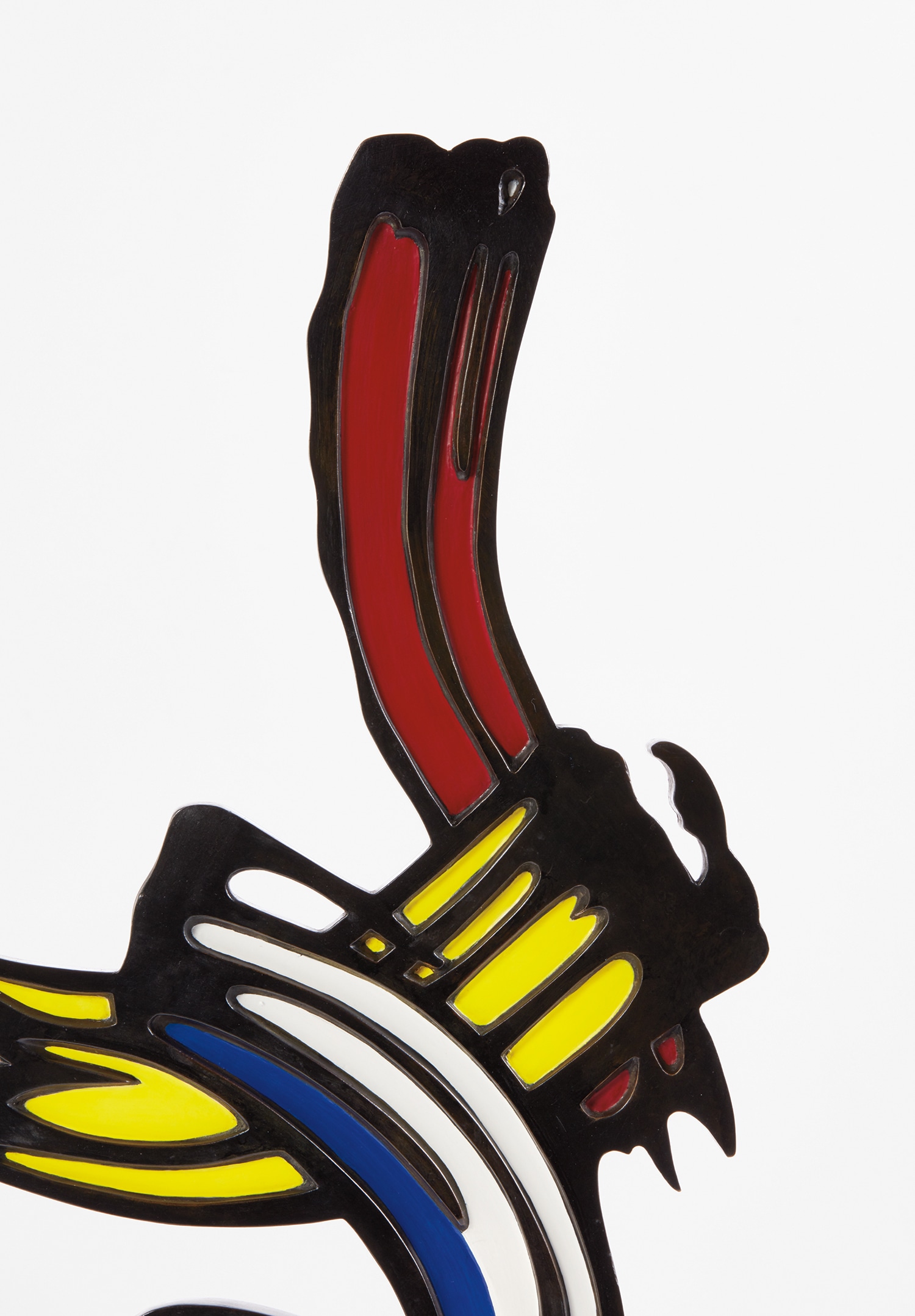













Property from the Miles and Shirley Fiterman Collection
8Ο
Roy Lichtenstein
Brushstroke Sculpture
incised with the artist's signature, number and date '3/6 rf Lichtenstein '81' and stamped with the Tallix foundry mark on the base
painted bronze
80 x 33 x 16.5 cm. (31 1/2 x 13 x 6 1/2 in.)
Executed in 1981, this work is number 3 from an edition of 6.
Full-Cataloguing
Like Andy Warhol’s soup-cans, Lichtenstein’s brushstrokes were, clearly and at first glance, generational icons. They proposed a critique of the immediate past, clearly intending to supersede it without destroying it—to propose something new that would renew the past, as well.”(Dave Hickey, “Brushstrokes”, from Brushstrokes: Four Decades, New York, 2002, p. 10).
As a seminal addition to the history of sculpture, Roy Lichtenstein’s definitive bronze, Brushstroke Sculpture, 1981, provides the ultimate challenge to our ideas on representation and the stylistic paradigms of 20th century visual culture. As the very first sculpture made by Lichtenstein on the brushstroke motif, the present work (from a limited edition of six) is testament to the prestige of the collection from which it originates, and the ability of its original owners – Miles and Shirley Fiterman – to acquire the most significant Pop Art pieces at the time of their production. In the present work the founding father of Pop Art employs his longstanding preoccupation with the mediation of images to a mesmerically confounding effect. Disrupting the traditional division between artistic mediums, Lichtenstein gives the art of painting three dimensional form. Executed in 1981, inaugurating an expansive series, Brushstroke Sculpture draws from the elegantly kitsch stylings of Lichtenstein’s iconic Brushstroke paintings of the mid 1960s. These groundbreaking paintings were based on cartoon-esque images of painted brushwork that Lichtenstein sourced from print media, forming a witty riposte to the supremacy of non-referential abstraction within the history of modern American painting. Further challenging the idea that painting in its purest form should refer solely to the act of painting itself, in Brushstroke Sculpture, Lichtenstein employs Duchampian strategies of dislocation and re-contextualisation, instead making a work of art that disrupts accepted definitions of art itself. Through his characteristic gloss of primary colours laid upon the classical medium of bronze, Lichtenstein narrows the gap between the avant-garde and popular culture; a schism that was expounded upon by post-war art critics such as Clement Greenberg and propagated by the Abstract Expressionist painters he championed in the early days of Lichtenstein’s career. As such, Brushstroke Sculpture represents the enduring centrality of pastiche as a visual tactic used by Lichtenstein as he constructed the radical parameters that defined Pop Art – the most important aesthetic and conceptual movement in the 20th century.
A crucial paradox of Lichtenstein’s engagement with the brushstroke motif is that he portrayed the ultimate symbol of self expression in a style that seems to completely efface the presence of the author. Rather than showing the artist's hand, he would defer representation to the ubiquitous and recognisable lexicon of graphic fiction. Brushstroke with Spatter, 1966, in the collection of the Art Institute of Chicago, is a paradigmatic example of how Lichtenstein parodied the expressive mark-making and bravura application of paint that had long dominated American painting in the 1950s. Long revered as a spiritualistic embodiment of the creative moment, when Lichtenstein thematised the Brushstroke Sculpture in the mid 1960s he represented common gestures from action painting – the splatters of Jackson Pollock or the raw unblended marks of Willem de Kooning and Franz Kline – with the thick black outlines and block primary colours. In his distinctive comic book style, actual brushstrokes that composed images of brushstrokes remained invisible. As the artist noted, "Visible brushstrokes in a painting convey a sense of grand gesture. But, in my hands, the brushstroke becomes a depiction of a grand gesture. So the contradiction between what I'm portraying and how I am portraying it is sharp." (Roy Lichtenstein, A Review of My work since 1961: a slide presentation, 1995, transcript online).
Whilst Lichtenstein engaged with different artistic styles and movements throughout his career, the present work comes from a period where he begins to re-engage with his own work, referencing past series. Created in 1981, the present work is the very first time that Lichtenstein transfers his iconic brushstroke motif to the medium of sculpture, thus giving it greater monumentality as an icon of his own making. As noted by renowned art critic and historian Hal Foster, the work is the first instance where “traditional bust meets abstract mannequin, Abstract Expressionist brushstroke meets cartoon sign of the same.” (Hal Foster, Roy Lichtenstein, Sculpture, New York and London, 2005). Lichtenstein constructs an elegant totem that enunciates a set of three brushstrokes in his characteristic bold black outlines and primary colours. A swirling vertical slick of white and blue supports a horizontal dash of ebullient yellow which in turn supports and vibrant red vertical swipe. Each is articulated as an image that holds a false sense of urgency, which is crucially at odds with the permanence of the medium. Lichtenstein conjures an idea of quick-handed expression with his erratic lines, despite the classically symbolic material or bronze requiring consideration and planning in its execution. As a medium that has been utilised from ancient times to the present day, Lichtenstein initiates an instance in which bronze is not simply painted, but becomes a representation of paint. Whilst sculpture occupied a central position in Lichtenstein’s oeuvre from the first time he cast a female figure in glazed ceramic in 1965, crucially Brushstroke Sculpture plays with our expectations of sculpture as a plastic and three dimensional medium. When Lichtenstein began his career, minimalist artists such as Frank Stella and Ellsworth Kelly were making paintings that presented themselves as objects; by 1981, in Brushstroke Sculpture, Lichtenstein reverses this transcendental process with great humor, creating a beguiling object that presents an unconvincing image of itself as paint.
As a seminal addition to the history of sculpture, Roy Lichtenstein’s definitive bronze, Brushstroke Sculpture, 1981, provides the ultimate challenge to our ideas on representation and the stylistic paradigms of 20th century visual culture. As the very first sculpture made by Lichtenstein on the brushstroke motif, the present work (from a limited edition of six) is testament to the prestige of the collection from which it originates, and the ability of its original owners – Miles and Shirley Fiterman – to acquire the most significant Pop Art pieces at the time of their production. In the present work the founding father of Pop Art employs his longstanding preoccupation with the mediation of images to a mesmerically confounding effect. Disrupting the traditional division between artistic mediums, Lichtenstein gives the art of painting three dimensional form. Executed in 1981, inaugurating an expansive series, Brushstroke Sculpture draws from the elegantly kitsch stylings of Lichtenstein’s iconic Brushstroke paintings of the mid 1960s. These groundbreaking paintings were based on cartoon-esque images of painted brushwork that Lichtenstein sourced from print media, forming a witty riposte to the supremacy of non-referential abstraction within the history of modern American painting. Further challenging the idea that painting in its purest form should refer solely to the act of painting itself, in Brushstroke Sculpture, Lichtenstein employs Duchampian strategies of dislocation and re-contextualisation, instead making a work of art that disrupts accepted definitions of art itself. Through his characteristic gloss of primary colours laid upon the classical medium of bronze, Lichtenstein narrows the gap between the avant-garde and popular culture; a schism that was expounded upon by post-war art critics such as Clement Greenberg and propagated by the Abstract Expressionist painters he championed in the early days of Lichtenstein’s career. As such, Brushstroke Sculpture represents the enduring centrality of pastiche as a visual tactic used by Lichtenstein as he constructed the radical parameters that defined Pop Art – the most important aesthetic and conceptual movement in the 20th century.
A crucial paradox of Lichtenstein’s engagement with the brushstroke motif is that he portrayed the ultimate symbol of self expression in a style that seems to completely efface the presence of the author. Rather than showing the artist's hand, he would defer representation to the ubiquitous and recognisable lexicon of graphic fiction. Brushstroke with Spatter, 1966, in the collection of the Art Institute of Chicago, is a paradigmatic example of how Lichtenstein parodied the expressive mark-making and bravura application of paint that had long dominated American painting in the 1950s. Long revered as a spiritualistic embodiment of the creative moment, when Lichtenstein thematised the Brushstroke Sculpture in the mid 1960s he represented common gestures from action painting – the splatters of Jackson Pollock or the raw unblended marks of Willem de Kooning and Franz Kline – with the thick black outlines and block primary colours. In his distinctive comic book style, actual brushstrokes that composed images of brushstrokes remained invisible. As the artist noted, "Visible brushstrokes in a painting convey a sense of grand gesture. But, in my hands, the brushstroke becomes a depiction of a grand gesture. So the contradiction between what I'm portraying and how I am portraying it is sharp." (Roy Lichtenstein, A Review of My work since 1961: a slide presentation, 1995, transcript online).
Whilst Lichtenstein engaged with different artistic styles and movements throughout his career, the present work comes from a period where he begins to re-engage with his own work, referencing past series. Created in 1981, the present work is the very first time that Lichtenstein transfers his iconic brushstroke motif to the medium of sculpture, thus giving it greater monumentality as an icon of his own making. As noted by renowned art critic and historian Hal Foster, the work is the first instance where “traditional bust meets abstract mannequin, Abstract Expressionist brushstroke meets cartoon sign of the same.” (Hal Foster, Roy Lichtenstein, Sculpture, New York and London, 2005). Lichtenstein constructs an elegant totem that enunciates a set of three brushstrokes in his characteristic bold black outlines and primary colours. A swirling vertical slick of white and blue supports a horizontal dash of ebullient yellow which in turn supports and vibrant red vertical swipe. Each is articulated as an image that holds a false sense of urgency, which is crucially at odds with the permanence of the medium. Lichtenstein conjures an idea of quick-handed expression with his erratic lines, despite the classically symbolic material or bronze requiring consideration and planning in its execution. As a medium that has been utilised from ancient times to the present day, Lichtenstein initiates an instance in which bronze is not simply painted, but becomes a representation of paint. Whilst sculpture occupied a central position in Lichtenstein’s oeuvre from the first time he cast a female figure in glazed ceramic in 1965, crucially Brushstroke Sculpture plays with our expectations of sculpture as a plastic and three dimensional medium. When Lichtenstein began his career, minimalist artists such as Frank Stella and Ellsworth Kelly were making paintings that presented themselves as objects; by 1981, in Brushstroke Sculpture, Lichtenstein reverses this transcendental process with great humor, creating a beguiling object that presents an unconvincing image of itself as paint.